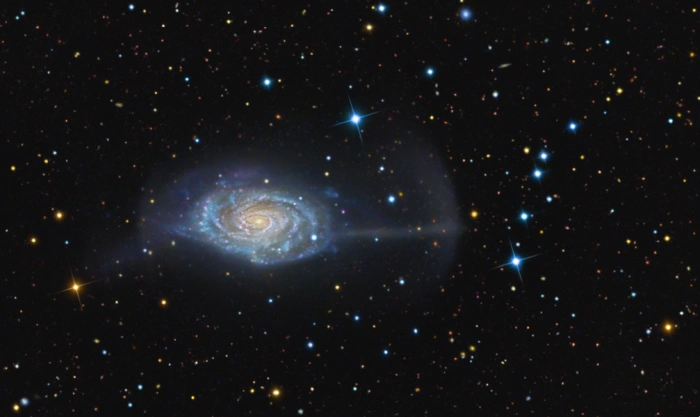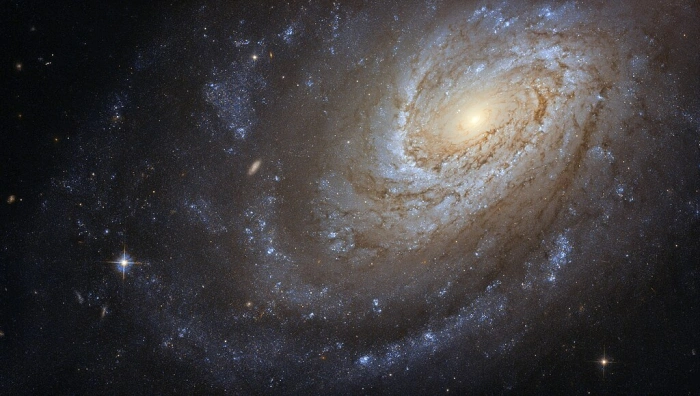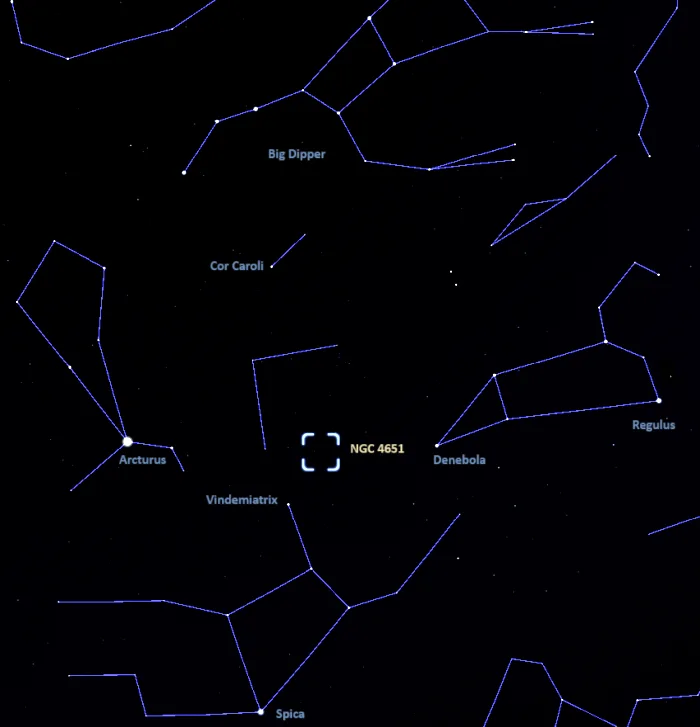The Umbrella Galaxy is a spiral galaxy located 72 million light years away in the northern constellation of Coma Berenices (Berenice’s Hair). It has an apparent magnitude of 11.39. It is listed as NGC 4651 in the New General Catalogue.
The Umbrella Galaxy is notable for its umbrella-like structure composed of stellar streams that extend away from the galaxy’s disk. These tidal streams of stars and gas are what is left of a much smaller companion that was absorbed into the larger NGC 4651. The stellar streams were gravitationally stripped from the smaller galaxy during the collision.
The Umbrella Galaxy is a twin of our own Milky Way galaxy. Its spiral arms are believed to closely resemble those of our galaxy. The galaxy has an active nucleus known as a LINER (Low-Ionization Nuclear Emission-line Region).

Umbrella Galaxy (NGC 4651), image credit: R. Jay GaBany (CC BY-SA 3.0)
The unusual shape of NGC 4651 earned the galaxy a spot in American astronomer Halton Arp’s Atlas of Peculiar Galaxies (1966), where it is catalogued as Arp 189. Halton Arp included NGC 4651 as a galaxy with narrow filaments.
The Umbrella Galaxy is a member of the Virgo Cluster, the nearest massive cluster of galaxies to the Local Group (the home of the Milky Way and the Andromeda Galaxy). The Virgo Cluster is part of the larger Virgo Supercluster, which also contains the Local Group. The centre of the Virgo Cluster is located 53.8 million light-years away.
The distance to NGC 4651 is uncertain. The value of 72 million light-years comes from a 2002 study of the Virgo Cluster galaxy distribution based on the galaxies’ H I content. However, other studies have given estimates in the range from 15 to 105 million light-years. More recent sources place the galaxy approximately 35 or 93 million light-years away.
The giant cosmic Umbrella has a diameter of 50,000 to 87,900 light-years, depending on its exact distance. The stellar stream extends for another 50,000 light years. With an apparent size of 4 by 2.6 arcminutes, NGC 4651 can be observed in amateur telescopes in good conditions.
Observations with radio telescopes have revealed distortions in the distribution of neutral hydrogen in the galaxy’s outer regions. Astronomers also detected a gas clump linked with a tidal dwarf galaxy that may have formed in the same collision that produced the streams of gas that extend to the east of NGC 4651.
The Umbrella Galaxy is rich in neutral hydrogen, which extends far beyond the optically visible galactic disk. While the stellar tail extends to the east in visible light, the H I clump extends to the west and forms a tail-like feature.
In 2014, observations with the Subaru and Keck telescopes and the Blackbird Observatory 0.5-metre instrument allowed astronomers to track the movement of the stars in the stellar stream of NGC 4651 and use the data to reconstruct the stream’s history. The team, led by Caroline Foster of the Australian Astronomical Observatory (AAO), found that the stream was the remnant of a single galaxy and not the product of multiple collisions. The study was published in the Monthly Notices of the Royal Astronomical Society in 2014.

This remarkable spiral galaxy, known as NGC 4651, may look serene and peaceful as it swirls in the vast, silent emptiness of space, but don’t be fooled — it keeps a violent secret. It is believed that this galaxy consumed another smaller galaxy to become the large and beautiful spiral that we observe today. Although only a telescope like the NASA/ESA Hubble Space Telescope, which captured this image, could give us a picture this clear, NGC 4651 can also be observed with an amateur telescope — so if you have a telescope at home and a star-gazing eye, look out for this glittering carnivorous spiral. Credit: European Space Agency (CC BY 2.0)
Facts
The Umbrella Galaxy was discovered by the German-born British astronomer William Herschel on December 30, 1783. The parasol shape was only detected in 1950s. At the time, scientists believed that the umbrella shaft and handle were a small satellite galaxy, a companion to the larger NGC 4651. The stream of stars was later discovered to be the debris of a companion.
The Umbrella Galaxy hosted two supernovae in the recent decades. The type II supernova SN 1987K had an apparent magnitude of 15 and was detected on July 28, 1987. Another type II supernova, SN 2006my, was discovered on November 6, 2006. It had a visual magnitude of 15.3.
Location
The Umbrella Galaxy is located in the faint Coma Berenices constellation. It lies northeast of the centre of the Virgo Cluster, which appears halfway between Denebola in Leo and Vindemiatrix in Virgo. The galaxy appears almost halfway between Denebola and the brighter Arcturus in the constellation Boötes (the Herdsman), just west of the orange giant star 27 Comae Berenices (mag. 5.12). In 10-inch telescopes, it appears as an elongated patch of light with a bright nucleus.
The galaxy lies near the centre of the Diamond of Virgo, a large spring asterism formed by Arcturus and Denebola with Spica in Virgo and Cor Caroli in Canes Venatici. The asterism dominates the evening sky throughout the northern hemisphere spring.
At declination +16° 23’, the Umbrella Galaxy is close enough to the celestial equator to be visible from both hemispheres for at least part of the year. It never rises from locations south of the latitude 74° S (the Antarctic Circle).

The location of the Umbrella Galaxy (NGC 4651), image: Stellarium
The best time of the year to observe the Umbrella Galaxy and other deep sky objects in Coma Berenices is during the month of May, when the constellation appears higher in the sky around 9 pm.
Umbrella Galaxy – NGC 4651
| Constellation | Coma Berenices |
| Object type | Spiral galaxy |
| Morphological type | SA(rs)c or Sc(dSc) |
| Right ascension | 12h 43m 42.6376070448s |
| Declination | +16° 23′ 36.002649300″ |
| Apparent magnitude | 11.39 |
| Apparent size | 4.0′ × 2.6′ |
| Distance | 72 million light-years (22.075 megaparsecs) or 35 million light-years (10.73 megaparsecs) |
| Redshift | 0.002706 |
| Heliocentric radial velocity | 810 ± 3 km/s |
| Size | ~87,900 light-years (26.95 kiloparsecs) or 50,000 light-years (15,330 parsecs) |
| Names and designations | Umbrella Galaxy, NGC 4651, Arp 189, APG 189, LEDA 42833, PGC 42833, UGC 7901, VV 56, MCG +03-33-001, CGCG 100-004, TIC 87606766, IRAS 12412+1639, IRAS F12412+1640, 2MASS J12434265+1623359, 2MASX J12434262+1623362, K73 549, HIPASS J1243+1, ISOSS J12437+1623, Z 100-4, Z 1241.3+1640, SDSS J124343.61+162347.4, SDSS J124342.64+162335.9, EVCC 1102, UZC J124342.7+162336, PSCz Q12412+1639 |